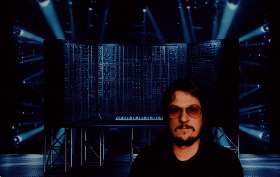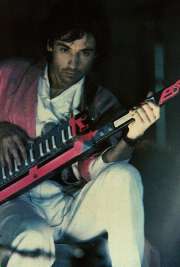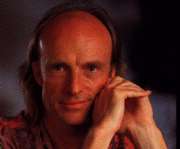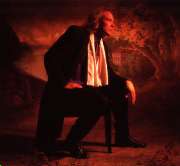Which
Are the Amazing Sounds?
By: Jorge Munnshe.
To define something as subjective as
music it always happens to be difficult. In the case of alternative
musics the difficulty is even greater, since these are
not a given style, but many, usually having very different
characteristics. Numerous are the labels applied to each one of
these genres. The borders separating them are not airtight, and
often a musician and even one given piece flow along different
paths. This is the most obvious example that artistic creativity
cannot be stylistically hindered by ropes that tie it to some
given patterns. Sooner or later, geniality comes to surface
outside these patterns. Breaking moulds, this could be
the general definition of alternative musics.
With respect to which trends or labels
integrate the alternative musics, these amazing
sounds that have the leading role in this virtual magazine, here
is a list, necessarily incomplete as it is, of the most
representative ones.
 PSYCHEDELIC ROCK. Connected to SYMPHONIC / PROGRESSIVE
ROCK, this is the most avant-garde area of rock. It is near to Cosmic
Music in some aspects. It appeared by the late '60s., with
pioneer bands, the most well known of which is Pink Floyd.
Artists like Mike Oldfield, Alan Parsons and Brian
Eno also have been classified within this trend. In
Germany a local movement began, known as KRAUT ROCK, which later
led to the rise of Cosmic and Techno
music.
PSYCHEDELIC ROCK. Connected to SYMPHONIC / PROGRESSIVE
ROCK, this is the most avant-garde area of rock. It is near to Cosmic
Music in some aspects. It appeared by the late '60s., with
pioneer bands, the most well known of which is Pink Floyd.
Artists like Mike Oldfield, Alan Parsons and Brian
Eno also have been classified within this trend. In
Germany a local movement began, known as KRAUT ROCK, which later
led to the rise of Cosmic and Techno
music.
COSMIC / AMBIENT / SPACE MUSIC. The
styles defined with these labels as a general rule utilize
synthesizers. The music tends to be ethereal, unearthly, and
easily awakes in the imagination of the listeners sensations that
they are travelling in space, living adventures typical of
science-fiction, or having other experiences outside what is
normal. It appeared in the early '70s, and its main initiators
were Tangerine Dream, Vangelis, Jean Michel Jarre, Klaus
Schulze and Ash Ra Tempel, who later
moved on towards other styles.
 TECHNO. It is an almost exclusively electronic
music, very rhythmic and as a general rule very apt for dancing.
It appeared in the early '70s with the band Kraftwerk
as the main pioneers, and during the '80s and the '90s it has
fostered the rise of numerous styles connected to its basic
concept and with other influences such as for instance punk, heavy metal or pop
in general. These new labels are: INDUSTRIAL,
TRANCE, TECHNO-AMBIENT, TECHNO-JAZZ, ELECTRONIC BODY MUSIC, CYBERPUNK,
CYBERDELIA, ACID HOUSE, TRIP HOP, HARDCORE and others.
TECHNO. It is an almost exclusively electronic
music, very rhythmic and as a general rule very apt for dancing.
It appeared in the early '70s with the band Kraftwerk
as the main pioneers, and during the '80s and the '90s it has
fostered the rise of numerous styles connected to its basic
concept and with other influences such as for instance punk, heavy metal or pop
in general. These new labels are: INDUSTRIAL,
TRANCE, TECHNO-AMBIENT, TECHNO-JAZZ, ELECTRONIC BODY MUSIC, CYBERPUNK,
CYBERDELIA, ACID HOUSE, TRIP HOP, HARDCORE and others.
AVANT-GARDE POP. It is connected to
diverse innovative styles, mostly related to Techno,
as for instance several of those mentioned in the previous
paragraph. The label ELECTRONIC MUSIC has also been used to
define several of the genres commented on before. COMPUTER MUSIC
has been used to distinguish the music created mainly by means of
a computer.
The WORLD MUSIC is based on the concept
of creating new musical forms by mixing the folk music from
different countries. Thus for example, when mixing elements of
Japanese traditional music with African percussive rhythms and European
medieval melodies, the result is a new, different music. This
genre was born in the late '60s, propitiated by the cultural
encounter of East and West that was initiated in that time. The World
Music has always had a markedly pacifist, cosmopolitan
character, symbolizing with its artistic personality the need to
abolish frontiers among the peoples all over the world. Artists
like Paul Winter and Peter Michael Hamel,
among them, were the initiators of this genre.
 The term NEW AGE began to be used in the late
'70s to identify a lifestyle more or less derived from the hippie
culture, and also to define several of these new musical styles, considered
to be related to this philosophy. Artists like Kitaro
were immediately classified under this label, thus becoming its
visible heads. However, the label has ended up by being applied
in numerous countries as a sort of megalabel for practically all
the new or unusual styles, with the only exception of those more
linked to Techno and sung pop.
The term NEW AGE began to be used in the late
'70s to identify a lifestyle more or less derived from the hippie
culture, and also to define several of these new musical styles, considered
to be related to this philosophy. Artists like Kitaro
were immediately classified under this label, thus becoming its
visible heads. However, the label has ended up by being applied
in numerous countries as a sort of megalabel for practically all
the new or unusual styles, with the only exception of those more
linked to Techno and sung pop.
Within the sector more clearly
identified with New Age, there are three
tendencies that not being separated musical styles in an obvious
way, do show their own personalities, quite connected to
philosophies of the New Age culture. Next we
describe them:
- THE ECOLOGICAL TENDENCY. An important element within the New
Age lifestyle is the love for nature and the support
given to the preservation of the ecosystem. The musical
reflection of such is obvious in the artists that incorporate
in their recordings the sounds of birds, waterfalls, the
tops of trees caressed by the breeze, and others of this
kind. Their music is in accordance with this
accompaniment, turning out to be pleasant, romantic,
almost heavenly. Sometimes even the release of these
records is an act to vindicate the protection of live
species in danger of extinction, or in support of other
similar initiatives. This tendency appeared in the early
'70s. Musicians such as Georg Deuter have
become their symbols.
- THE MYSTIC TENDENCY. A sector of the New Age
culture is linked to mystic questions, from those
influenced by the eastern philosophies, to others that
have existed independently from the New Age
but that in the latest years tend to be grouped around
this label. This aspect usually is reflected in music
under the form of recordings to accompany rituals, the
music resulting from spiritual experiences, or simply
that of pieces with titles inspired in these themes. This
tendency appeared in the late '60s. Artists like Paul
Horn and Popol Vuh, among
others, are clear samples of this trend.
- MUSIC FOR RELAXATION, MEDITATION AND THERAPY. A part of
the music made known under the label New Age
does not have as its main aim to entertain the audience,
but rather to liberate positive curative effects on their
 mental
health. The stress of everyday life makes it difficult
for many people to relax after a stressing day. Listening
to music especially designed to relax can be the ideal
way to free oneself from a very harmful nervousness.
Other applications can be to induce states of mind
inclined to creativity or to meditating with sufficient
concentration on complex issues. Also recordings have
been made as a support to mental therapies in hospitals.
This musical concept began to be applied in the late
'60s. Among its main followers, we must mention Steven
Halpern and the record label New World.
mental
health. The stress of everyday life makes it difficult
for many people to relax after a stressing day. Listening
to music especially designed to relax can be the ideal
way to free oneself from a very harmful nervousness.
Other applications can be to induce states of mind
inclined to creativity or to meditating with sufficient
concentration on complex issues. Also recordings have
been made as a support to mental therapies in hospitals.
This musical concept began to be applied in the late
'60s. Among its main followers, we must mention Steven
Halpern and the record label New World.
NEW INSTRUMENTAL MELODIC MUSIC. As an
alternative to the sung music and the conventional instrumental
genres, an increasing number of artists compose music that has
been described as the CLASSICAL MUSIC OF THE PRESENT, as it is
considered that Classical Music has more in
common with it than with the apparently official continuations
promoted from the scholarly sectors. The New Instrumental
Melodic Music can also have Pop and Jazz
traits as well in those trends farthest from Classical
Music and nearer to modern music. Among
the stars of the New Instrumental Melodic Music
most noteworthy are Suzanne Ciani, Yanni, Ray Lynch, Bill
Douglas, Rick Wakeman, Andreas Vollenweider, Mark Isham, David
Arkenstone, and David Lanz, among many
others. The MOST INNOVATIVE SECTOR OF JAZZ has also exchanged
influences with the avant-garde styles.
 Some trends with far less followers than those
here mentioned so far have nevertheless existed for much longer.
These are in no way artistic trends with a true transcendental presence
in society, but rather they are directions of experimentation
kept by a minority of musicians and researchers. CONTEMPORARY
MUSIC is characterized by its unusual, innovative constructions,
elaborated from rather acoustic instruments. Linked to it there
is ELECTROACOUSTIC MUSIC, which pursues the same objectives yet
it widens its field of action to the joint activity of acoustic
and electronic instruments. CONCRETE MUSIC, born in France,
experiences with sounds. TAPE MUSIC is specialized in the
processing of sound and the construction of musical structures
from the recording of tapes and their further manipulation. All
these trends began to appear mostly by the late '40s. Musicians such as for instance
John Cage were doing an important pioneer work.
Some trends with far less followers than those
here mentioned so far have nevertheless existed for much longer.
These are in no way artistic trends with a true transcendental presence
in society, but rather they are directions of experimentation
kept by a minority of musicians and researchers. CONTEMPORARY
MUSIC is characterized by its unusual, innovative constructions,
elaborated from rather acoustic instruments. Linked to it there
is ELECTROACOUSTIC MUSIC, which pursues the same objectives yet
it widens its field of action to the joint activity of acoustic
and electronic instruments. CONCRETE MUSIC, born in France,
experiences with sounds. TAPE MUSIC is specialized in the
processing of sound and the construction of musical structures
from the recording of tapes and their further manipulation. All
these trends began to appear mostly by the late '40s. Musicians such as for instance
John Cage were doing an important pioneer work.
MINIMALIST MUSIC. This is a genre that
appeared from all the experimental directions commented in the
previous paragraph. Unlike the other trends, this one has
registered a remarkable success among the audience, becoming a
genre with a clear social impact. Minimalist Music
is based on the repetition of sequences of notes or basic
elements, with slightly different shades, in such a way that an
hypnotic environment is created. It is also known as REPETITIVE
MUSIC. Among its main followers we must mention Steve
Reich, Philip Glass and Wim Mertens.
Lastly, EXPERIMENTAL MUSIC in general
and FOLK MUSIC can be considered within the scope of the alternative musics
as well. The former, because of its obvious activity in search of
new musical forms. The latter, because the folklore of a given
country tends to be unknown, and therefore, new, exotic, for the
listeners from other countries. This has been the case of CELTIC
MUSIC, and that coming from places like India and the Tibet,
among others.
 Previous Page
(What's All This!)
Previous Page
(What's All This!)
 PSYCHEDELIC ROCK. Connected to SYMPHONIC / PROGRESSIVE
ROCK, this is the most avant-garde area of rock. It is near to Cosmic
Music in some aspects. It appeared by the late '60s., with
pioneer bands, the most well known of which is Pink Floyd.
Artists like Mike Oldfield, Alan Parsons and Brian
Eno also have been classified within this trend. In
Germany a local movement began, known as KRAUT ROCK, which later
led to the rise of Cosmic and Techno
music.
PSYCHEDELIC ROCK. Connected to SYMPHONIC / PROGRESSIVE
ROCK, this is the most avant-garde area of rock. It is near to Cosmic
Music in some aspects. It appeared by the late '60s., with
pioneer bands, the most well known of which is Pink Floyd.
Artists like Mike Oldfield, Alan Parsons and Brian
Eno also have been classified within this trend. In
Germany a local movement began, known as KRAUT ROCK, which later
led to the rise of Cosmic and Techno
music. TECHNO. It is an almost exclusively electronic
music, very rhythmic and as a general rule very apt for dancing.
It appeared in the early '70s with the band Kraftwerk
as the main pioneers, and during the '80s and the '90s it has
fostered the rise of numerous styles connected to its basic
concept and with other influences such as for instance punk, heavy metal or pop
in general. These new labels are:
TECHNO. It is an almost exclusively electronic
music, very rhythmic and as a general rule very apt for dancing.
It appeared in the early '70s with the band Kraftwerk
as the main pioneers, and during the '80s and the '90s it has
fostered the rise of numerous styles connected to its basic
concept and with other influences such as for instance punk, heavy metal or pop
in general. These new labels are:  The term NEW AGE began to be used in the late
'70s to identify a lifestyle more or less derived from the hippie
culture, and also to define several of these new musical styles, considered
to be related to this philosophy. Artists like Kitaro
were immediately classified under this label, thus becoming its
visible heads. However, the label has ended up by being applied
in numerous countries as a sort of megalabel for practically all
the new or unusual styles, with the only exception of those more
linked to Techno and sung pop.
The term NEW AGE began to be used in the late
'70s to identify a lifestyle more or less derived from the hippie
culture, and also to define several of these new musical styles, considered
to be related to this philosophy. Artists like Kitaro
were immediately classified under this label, thus becoming its
visible heads. However, the label has ended up by being applied
in numerous countries as a sort of megalabel for practically all
the new or unusual styles, with the only exception of those more
linked to Techno and sung pop. mental
health. The stress of everyday life makes it difficult
for many people to relax after a stressing day. Listening
to music especially designed to relax can be the ideal
way to free oneself from a very harmful nervousness.
Other applications can be to induce states of mind
inclined to creativity or to meditating with sufficient
concentration on complex issues. Also recordings have
been made as a support to mental therapies in hospitals.
This musical concept began to be applied in the late
'60s. Among its main followers, we must mention Steven
Halpern and the record label New World.
mental
health. The stress of everyday life makes it difficult
for many people to relax after a stressing day. Listening
to music especially designed to relax can be the ideal
way to free oneself from a very harmful nervousness.
Other applications can be to induce states of mind
inclined to creativity or to meditating with sufficient
concentration on complex issues. Also recordings have
been made as a support to mental therapies in hospitals.
This musical concept began to be applied in the late
'60s. Among its main followers, we must mention Steven
Halpern and the record label New World. Some trends with far less followers than those
here mentioned so far have nevertheless existed for much longer.
These are in no way artistic trends with a true transcendental presence
in society, but rather they are directions of experimentation
kept by a minority of musicians and researchers. CONTEMPORARY
MUSIC is characterized by its unusual, innovative constructions,
elaborated from rather acoustic instruments. Linked to it there
is ELECTROACOUSTIC MUSIC, which pursues the same objectives yet
it widens its field of action to the joint activity of acoustic
and electronic instruments. CONCRETE MUSIC, born in France,
experiences with sounds. TAPE MUSIC is specialized in the
processing of sound and the construction of musical structures
from the recording of tapes and their further manipulation. All
these trends began to appear mostly by the late '40s. Musicians such as for instance
John Cage were doing an important pioneer work.
Some trends with far less followers than those
here mentioned so far have nevertheless existed for much longer.
These are in no way artistic trends with a true transcendental presence
in society, but rather they are directions of experimentation
kept by a minority of musicians and researchers. CONTEMPORARY
MUSIC is characterized by its unusual, innovative constructions,
elaborated from rather acoustic instruments. Linked to it there
is ELECTROACOUSTIC MUSIC, which pursues the same objectives yet
it widens its field of action to the joint activity of acoustic
and electronic instruments. CONCRETE MUSIC, born in France,
experiences with sounds. TAPE MUSIC is specialized in the
processing of sound and the construction of musical structures
from the recording of tapes and their further manipulation. All
these trends began to appear mostly by the late '40s. Musicians such as for instance
John Cage were doing an important pioneer work.